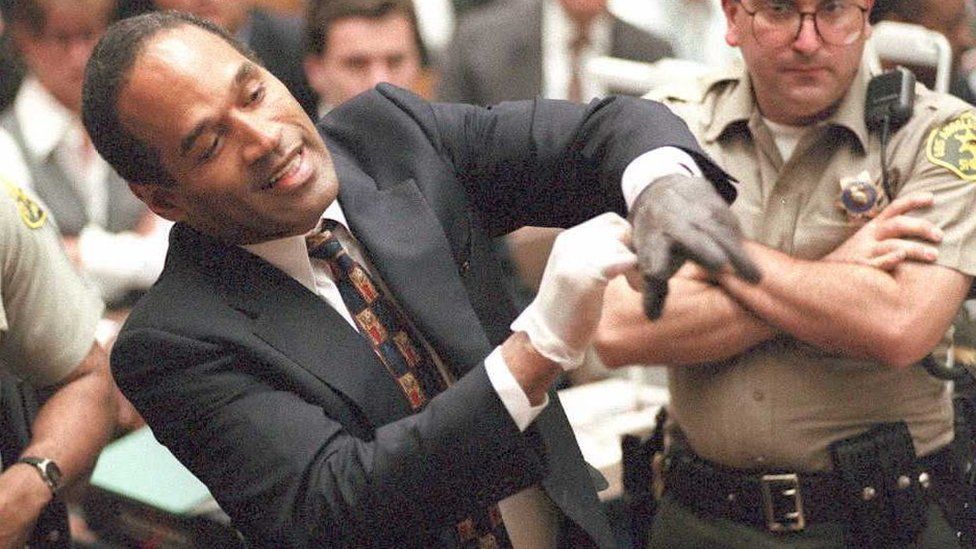OJ Simpson: A history of the fallen US football icon
- Published

OJ Simpson has been granted parole and could be released from prison as early as October. He was jailed in 2008 for armed robbery after taking memorabilia from his football career from dealers in a Las Vegas hotel room.
While the case has no connection to his infamous 1995 acquittal in a double murder trial, Simpson's release would thrust a man that a poll suggests three-quarters of Americans believe is probably guilty of those killings back into the spotlight.
Here's a recap of the key details of the OJ story.
One of the defining images of OJ Simpson's fall from grace, for many people, was broadcast live on television on 17 June, 1994.
Imagine your childhood sports hero - an icon beloved across the country - suddenly captured in a car chase with police along the freeways of Los Angeles.
In the back seat of the white Ford Bronco was Simpson, holding a gun and being driven by an old friend, Al Cowlings. The former NFL player had been charged with the bloody murders of his ex-wife, Nicole Brown Simpson, and her friend, Ronald Goldman, who had been found stabbed to death outside her condominium in LA's affluent Brentwood neighbourhood.
He had earlier agreed to turn himself in to police but decided to flee instead.
Crowds waved and egged on the man they called "The Juice" - an African-American athlete who had risen to fame in the late 1960s and later used his status as a springboard to a lucrative career in acting, sports commentary and television advertising, including a role in the Naked Gun films.
The two-hour chase ended at Simpson's home - where he eventually surrendered.
The scenes gripped a nation and the legal proceedings that followed were dubbed "the trial of the century" by the American media - with scenes from the courtroom broadcast to millions.
The media sensation around the OJ trial took place against the backdrop of an America racially divided in its opinion on the case.
And the sensational proceedings occurred in a city - Los Angeles - where trust between police and the black community had been shredded by the 1992 acquittal of police officers for using excessive force in the videotaped beating of Rodney King, which triggered the LA riots.
Most white Americans thought he was guilty and most African-Americans thought he was innocent, polls suggested. Simpson's alleged history of domestic violence came up during the trial, with police records revealing Nicole Brown Simpson required hospital treatment after being beaten by her husband in early 1989.
During the trial, OJ famously tried on a pair of bloody gloves - one of which was found at the murder scene - which did not appear to fit him, a moment seen as a major blow for the prosecution.
Simpson was - to the shock of many - found not guilty by the jury of the murders on 3 October 1995.
The legal "dream team" defending him had, as the recent eight-hour, Oscar-winning documentary OJ: Made in America makes clear, put race front and centre in the trial, despite Simpson having not previously associated himself strongly with the black community and the civil rights struggle.
"Not only did we play the race card, we dealt if from the bottom of the deck," Robert Shapiro, one of Simpson's lawyers, would say after the verdict.
But the families of Ronald Goldman and Nicole Brown Simpson pursued Simpson in a civil case which in 1997 found him responsible for the pair's deaths and ordered him to pay the families tens of millions of dollars - most of which is still outstanding.
Ten years later, in September 2007, Simpson and a group of associates stormed a hotel room in Las Vegas where two sports memorabilia dealers had items that Simpson considered to be rightfully his. Two of the men with Simpson were armed.
He was convicted in October 2008 on a litany of charges, including armed robbery, assault and kidnapping, and sentenced to at least nine years in prison, and a maximum 33-year term.
Some observers, including Simpson's lawyer, described the jury's decision as "payback" for the 1995 acquittal.
As part of the process of obtaining the money they were owed from the civil case, the Goldman family was in 2007 awarded the rights to If I Did It, Simpson's controversial ghost-written book describing how he would have committed the murders, had he been responsible.
They republished it with new commentary but significantly shrank the size of the word "if" on the cover, and added the subtitle Confessions of the Killer.
And while the 1994 murders remain unsolved, that is how many Americans see "OJ" today.
- Published1 April 2016
- Published4 March 2016